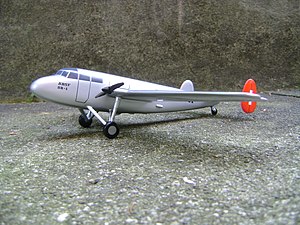| SB-1 | |
|---|---|

| |
| A model of the SB-1 | |
| Role | Twin-engined utility transport |
| National origin | Switzerland |
| Manufacturer | Pilatus Flugzeugwerke AG |
The Pilatus SB-1 was a single-engined twin-propeller utility transport development project of Pilatus Flugzeugwerke AG from Switzerland, during World War II, (SB - Schweizer Bergflugzeug - Swiss mountain aircraft).
Design and development[edit]
The SB-1 was intended as a pure experimental aircraft, designed with a mid-wing monoplane with accommodation for pilot and observer side by side in the cockpit and two passengers in a cabin directly behind the cockpit. The fuselage was to have built-up from welded steel tube covered with light-alloy and fabric. The aircraft would have been powered by a single Argus As 10E / Argus As 410 air-cooled V-8 engine, located at the center of gravity, in the fuselage, below the wing centre-section. The engine drove two-bladed propellers, driven by V-belts and idlers, mounted on the wing leading-edges either side of the fuselage, reducing drag and imbuing favorable low-speed flight characteristics due to the air flow of the propellers acting directly on the leading edge of the wing. The SB-1 was designed with a fixed tail-wheel undercarriage and also had a twin-fin tail unit. A study was also made of two engines mounted in the fuselage, each driving a separate propeller. Development of this project was abandoned before metal was cut.[1]
Pilatus "SB" projects[edit]
- SB-1
- Intended as a pure experimental aircraft, commercial use was not planned.
- SB-2 Pelican
- The only SB project to be built and flown.
- SB-5
- An enlargement of the SB-2, abandoned before construction began.
- (Nothing is known about possible SB-3 or SB-4 designs).
Specifications (SB-1)[edit]
Data from[citation needed]
General characteristics
- Crew: one
- Capacity: up to 3 passengers
- Length: 10.3 m (33 ft 10 in)
- Wingspan: 15 m (49 ft 3 in)
- Powerplant: 1 × Argus As 10E / Argus As 410 V-8 air-cooled inverted piston engines, 336 kW (451 hp)
Performance
- Maximum speed: 250 km/h (160 mph, 130 kn)
- Wing loading: 26 kg/m2 (5.3 lb/sq ft)
References[edit]
- ^ Gross, Kuno (2019). Pilatus SB-2 Pelican Das Schweizer Bergflugzeug 1938–1949 (in German) (1. Auflage ed.). Studienbüro für Spezialflugzeuge. ISBN 978-3-7494-3640-8.
Further reading[edit]
- Eichenberger, Roland (1989). Pilatus Flugzeuge: 1939–1989 (in German). Stans: Pilatus Flugzeugwerke.